lights CHEVROLET EXPRESS 1996 1.G Owners Manual
[x] Cancel search | Manufacturer: CHEVROLET, Model Year: 1996, Model line: EXPRESS, Model: CHEVROLET EXPRESS 1996 1.GPages: 376, PDF Size: 18.83 MB
Page 11 of 376
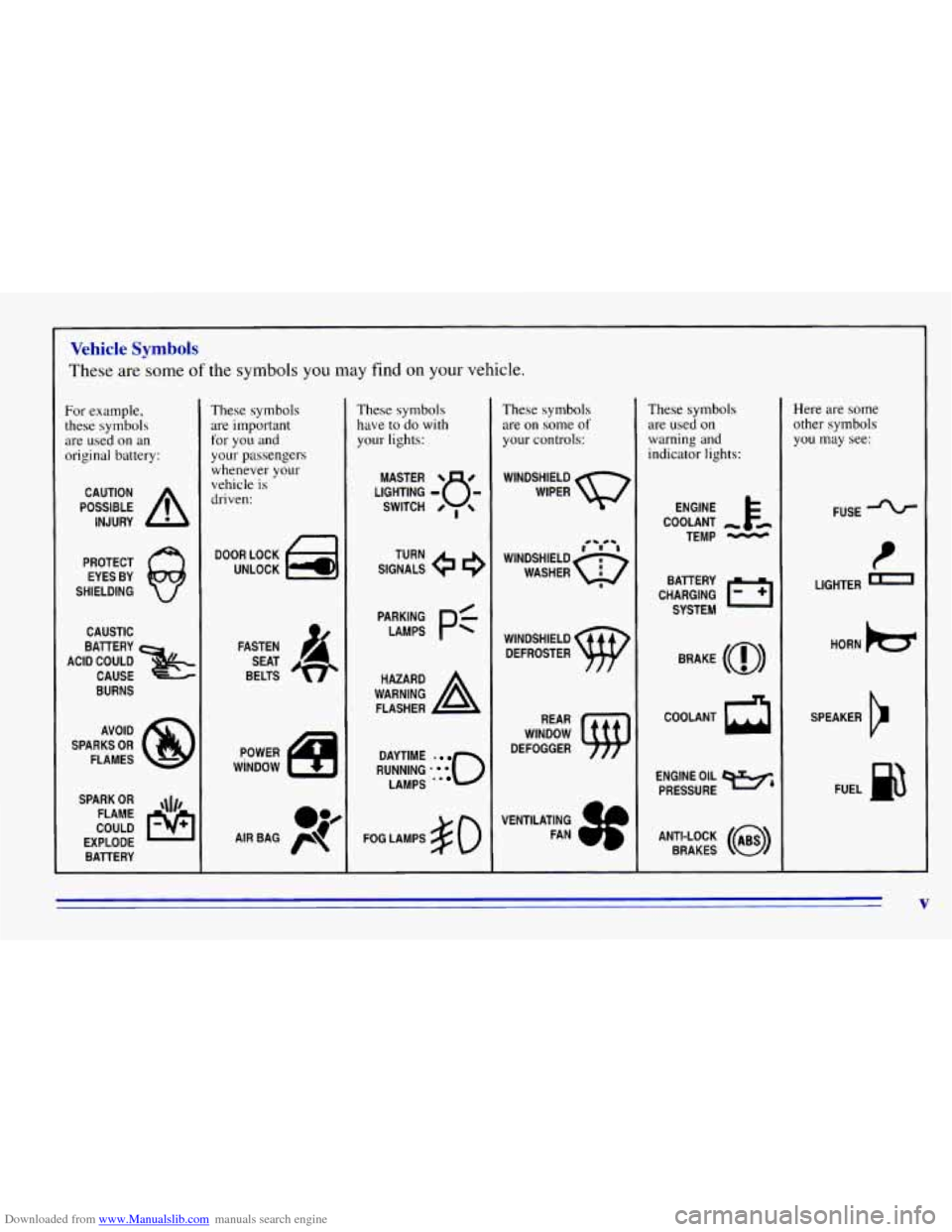
Downloaded from www.Manualslib.com manuals search engine Vehicle Symbols
These are some of the symbols you may find on your vehicle.
For example,
these symbols
are used
on an
original battery:
POSSIBLE A
CAUTION
INJURY
PROTECT EYES BY
SHIELDING
CAUSTIC
ACID COULD BATTERY
CAUSE
BURNS
SPARK
OR ,\I/,
COULD FLAME
EXPLODE BATTERY
These symbols
are important
for
you and
your passengers
whenever your
vehicle
is
driven:
DOOR LOCK
UNLOCK
FASTEN SEAT
BELTS
These symbols have to do with
your lights:
SIGNALS e e
TURN
RUNNING
-0
DAYTIME
LAMPS -*
FOG LAMPS # 0
These symbols
are on some of
your controls:
WINDSHIELD
DEFROSTER
VENTILATING FAN
These symbols
are used on
warning and
indicator lights:
COOLANT -
TEMP -
CHARGING BATTERY
SYSTEM
BRAKE
(0)
COOLANT a
ENGINE OIL e,
PRESSURE
ANTI-LOCK
(@)
BRAKES
Here are some
other symbols
you may see:
FUSE
t
LIGHTER -
HORN )tr
SPEAKER
b
FUEL m
V
Page 97 of 376

Downloaded from www.Manualslib.com manuals search engine Lamps
Your parking/headlamp switch is on the driver’s
side
of your instrument panel.
Your instrument panel dimmer wheel has two
detent positions. When
the wheel is turned
to full brightness, and then
into
the first detent position, the radio display and
PRNDL display
will go to the day mode (full intensity).
This is known as “parade” mode. The rest
of the I/P
illumination will stay
in the maximum dimming state
(full brightness dimming). Turning the wheel up one
more detent will activate the interior dome light circuit
(with slightly higher effort).
Rotate the switch knob clockwise
to the parking lamp
symbol to
turn on:
0 Parking Lamps
Sidemarker Lamps
0 Taillamps
0 License Plate Lamps
Instrument Panel Lights
0 Ashtray Lamp
0 Glove Box Lamp
2-35
Page 98 of 376
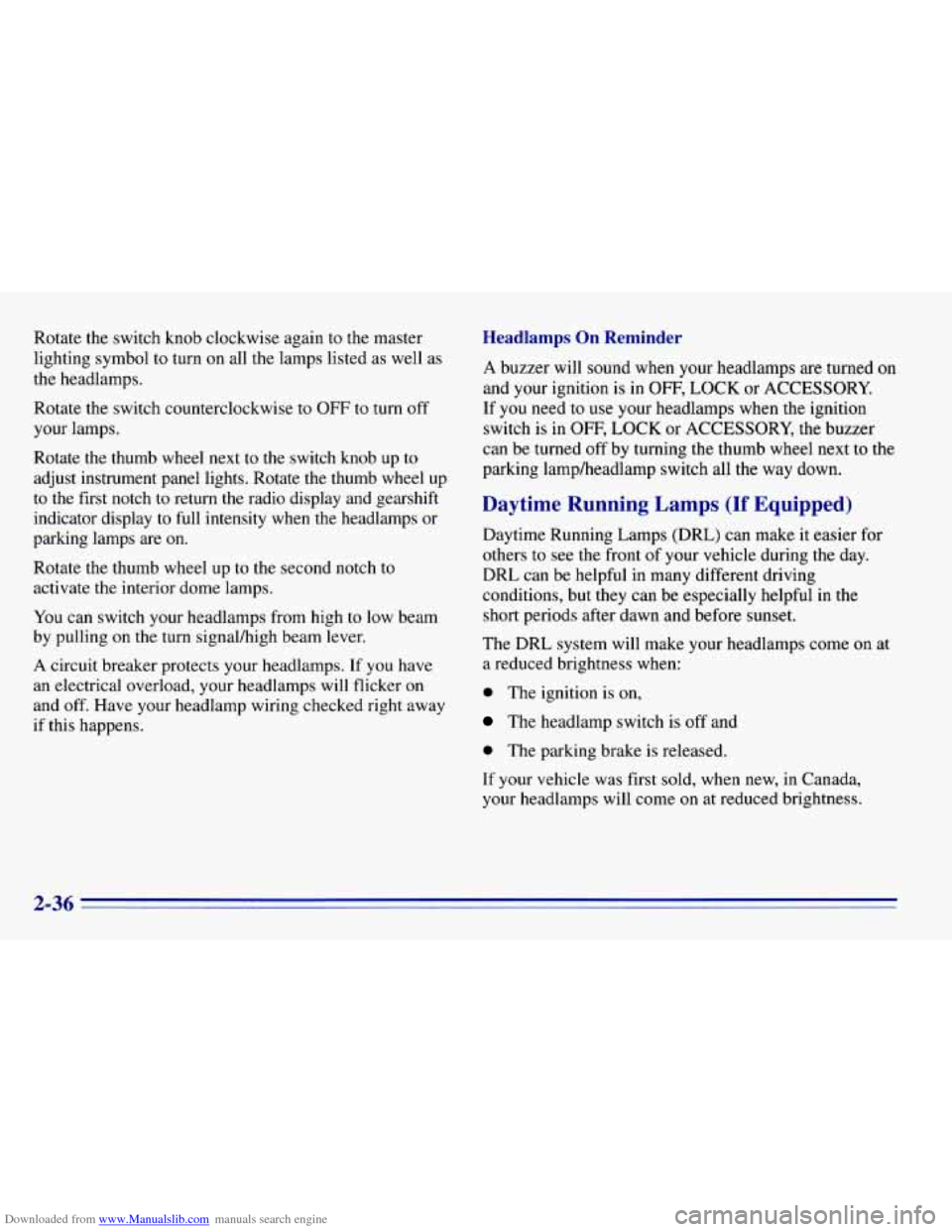
Downloaded from www.Manualslib.com manuals search engine Rotate the switch knob clockwise again to the master
lighting symbol
to turn on all the lamps listed as well as
the headlamps.
Rotate the switch counterclockwise to
OFF to turn off
your lamps.
Rotate the thumb wheel next
to the switch knob up to
adjust instrument panel lights. Rotate the thumb wheel up
to the first notch to return the radio display and gearshift
indicator display
to full intensity when the headlamps or
parking lamps are
on.
Rotate the thumb wheel up to the second notch to
activate the interior dome lamps.
You can switch your headlamps from high to low beam
by pulling
on the turn signalhigh beam lever.
A circuit breaker protects your headlamps. If you have
an electrical overload, your headlamps will flicker on
and off. Have your headlamp wiring checked right away
if this happens.
Headlamps On Reminder
A buzzer will sound when your headlamps are turned on
and your ignition is in OFF, LOCK or ACCESSORY.
If
you need to use your headlamps when the ignition
switch is in
OFF, LOCK or ACCESSORY, the buzzer
can be turned off by turning the thumb wheel next to the
parking lampheadlamp switch all the way down.
Daytime Running Lamps (If Equipped)
Daytime Running Lamps (DRL) can make it easier for
others
to see the front of your vehicle during the day.
DRL can be helpful in many different driving
conditions, but they can be especially helpful in the
short periods after dawn and before sunset.
The DRL system will make your headlamps come
on at
a reduced brightness when:
0 The ignition is on,
The headlamp switch is off and
0 The parking brake is released.
If your vehicle was first sold, when new, in Canada,
your headlamps will come
on at reduced brightness.
2-36
Page 108 of 376
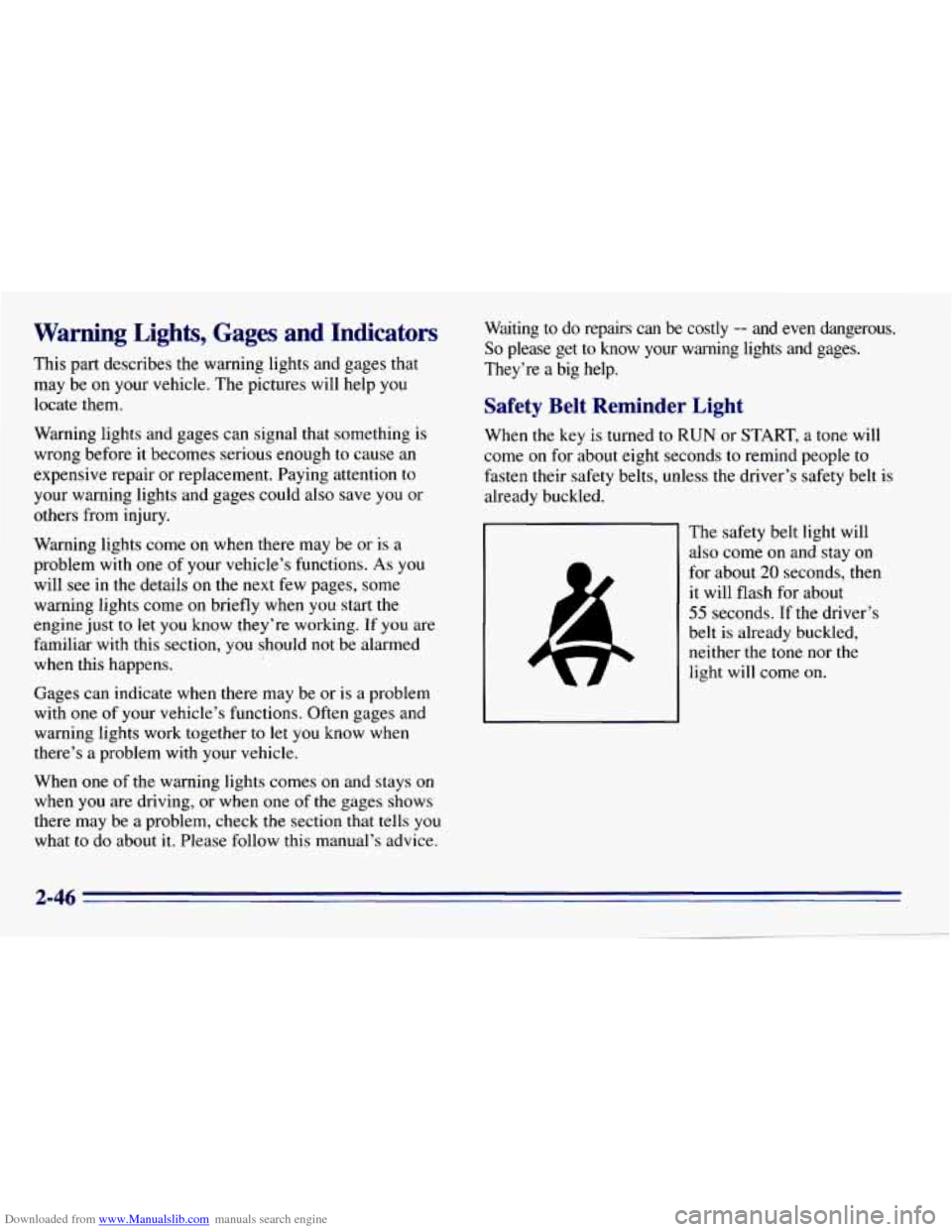
Downloaded from www.Manualslib.com manuals search engine Warning Lights, Gages and Indicators
This part describes the warning lights and gages that
may be on your vehicle. The pictures will help
you
locate them.
Warning lights and gages can signal that something
is
wrong before it becomes serious enough to cause an
expensive repair or replacement. Paying attention to
your warning lights and gages could also save
you or
others from injury.
Warning lights come on when there may be or is a
problem with one
of your vehicle’s functions. As you
will see in the details on the next few pages, some
warning lights come on briefly when
you start the
engine just to let
you know they’re working. If you are
familiar with this section,
you should not be alarmed
when this happens.
Gages can indicate when there may be or is a problem
with one
of your vehicle’s functions. Often gages and
warning lights work together
to let you know when
there’s a problem with your vehicle.
When one of the warning lights comes
on and stays on
when
you are driving, or when one of the gages shows
there may
be a problem, check the section that tells you
what to do about it. Please follow this manual’s advice. Waiting
to do
repairs can be costly -- and even dangerous.
So please get to know your warning lights and gages.
They’re a big help.
Safety Belt Reminder Light
When the key is turned to RUN or START, a tone will
come on for about eight seconds
to remind people to
fasten their safety belts, unless the driver’s safety belt is
already buckled.
The safety belt light will
also come on and stay
on
for about 20 seconds, then
it will flash for about
55 seconds. If the driver’s
belt is already buckled,
neither the tone nor the
light will come
on.
Page 166 of 376

Downloaded from www.Manualslib.com manuals search engine Here are some tips on night driving.
0
0
0
0
0
0
0
Drive defensively.
Don’t drink and drive.
Adjust your inside rearview mirror to reduce the
glare from headlamps behind you.
Since you can’t see as well, you may need to
slow down and keep more space between
you
and other vehicles.
Slow down, especially on higher speed roads.
Your
headlamps can light up only so much road ahead.
In remote areas, watch for animals.
If you’re tired, pull off the road in a safe place
and rest.
Night Vision
No one can see as well at night as in the daytime. But as
we get older these differences increase.
A 50-year-old
driver may require at least twice
as much light to see the
same thing at night as a 20-year-old.
What you do
in the daytime can also affect your night
vision. For example,
if you spend the day in bright
sunshine
you are wise to wear sunglasses. Your eyes will have less trouble adjusting
to night. But if you’re
driving, don’t wear sunglasses at night. They may cut
down
on glare from headlamps, but they also make a
lot of things invisible.
You can be temporarily blinded by approaching
headlamps.
It can take a second or two, or even several
seconds, for your eyes to readjust to
the dark. When you
are faced
with severe glare (as from a driver who
doesn’t lower the high beams, or
a vehicle with
misaimed headlamps), slow down a little. Avoid staring
directly into the approaching headlamps.
Keep your windshield and all the glass on your vehicle
clean
-- inside and out. Glare at night is made much
worse by dirt on the glass. Even the inside of the glass
can build up a film caused by dust. Dirty glass makes
lights dazzle and flash more than clean glass would,
making the pupils
of your eyes contract repeatedly.
Remember that your headlamps light up far less
of a
roadway when you are in a turn or curve. Keep your
eyes moving; that way, it’s easier to pick out dimly
lighted objects. Just as your headlamps should be
checked regularly for proper aim,
so should your eyes
be examined regularly. Some drivers suffer from night
blindness
-- the inability to see in dim light -- and aren’t
even aware
of it.
4-14
Page 248 of 376
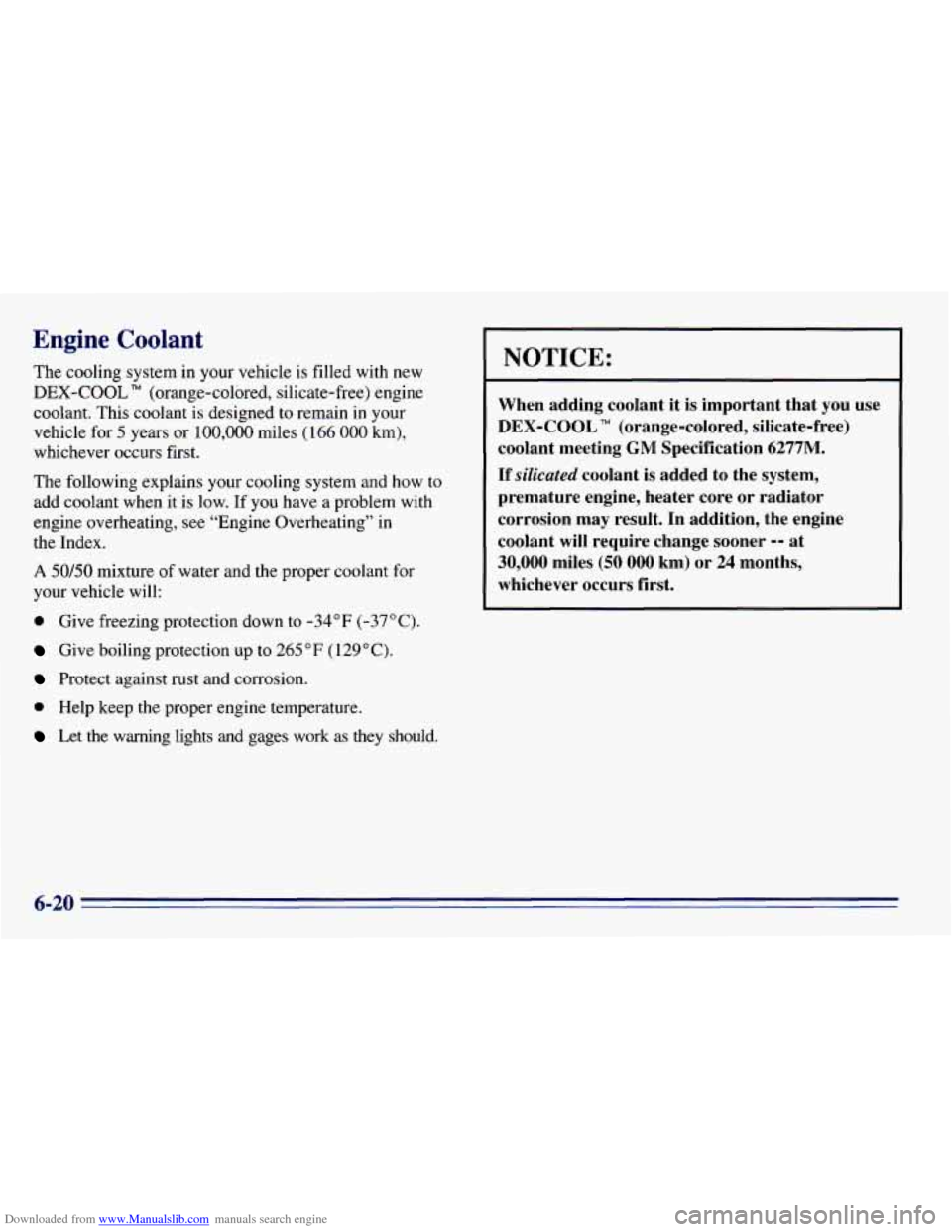
Downloaded from www.Manualslib.com manuals search engine Engine Coolant
The cooling system in your vehicle is filled with new
DEX-COOL
TM (orange-colored, silicate-free) engine
coolant. This coolant is designed to remain
in your
vehicle for 5 years or 100,000 miles ( 166 000 km),
whichever occurs first.
The following explains your cooling system and how
to
add coolant when it is low. If you have a problem with
engine overheating, see “Engine Overheating” in
the Index.
A 5060 mixture of water and the proper coolant for
your vehicle will:
0 Give freezing protection down to -34°F (-37°C).
Give boiling protection up to 265 “F ( 129 O C).
Protect against rust and corrosion.
0 Help keep the proper engine temperature.
Let the warning lights and gages work as they should.
NOTICE:
When adding coolant it is important that you use
DEX-COOL TM (orange-colored, silicate-free)
coolant meeting
GM Specification 6277M.
If silicated coolant is added to the system,
premature engine, heater core or radiator
corrosion may result. In addition, the engine coolant
will require change sooner -- at
30,000 miles (50 000 km) or 24 months,
whichever occurs first.
6-20
Page 369 of 376
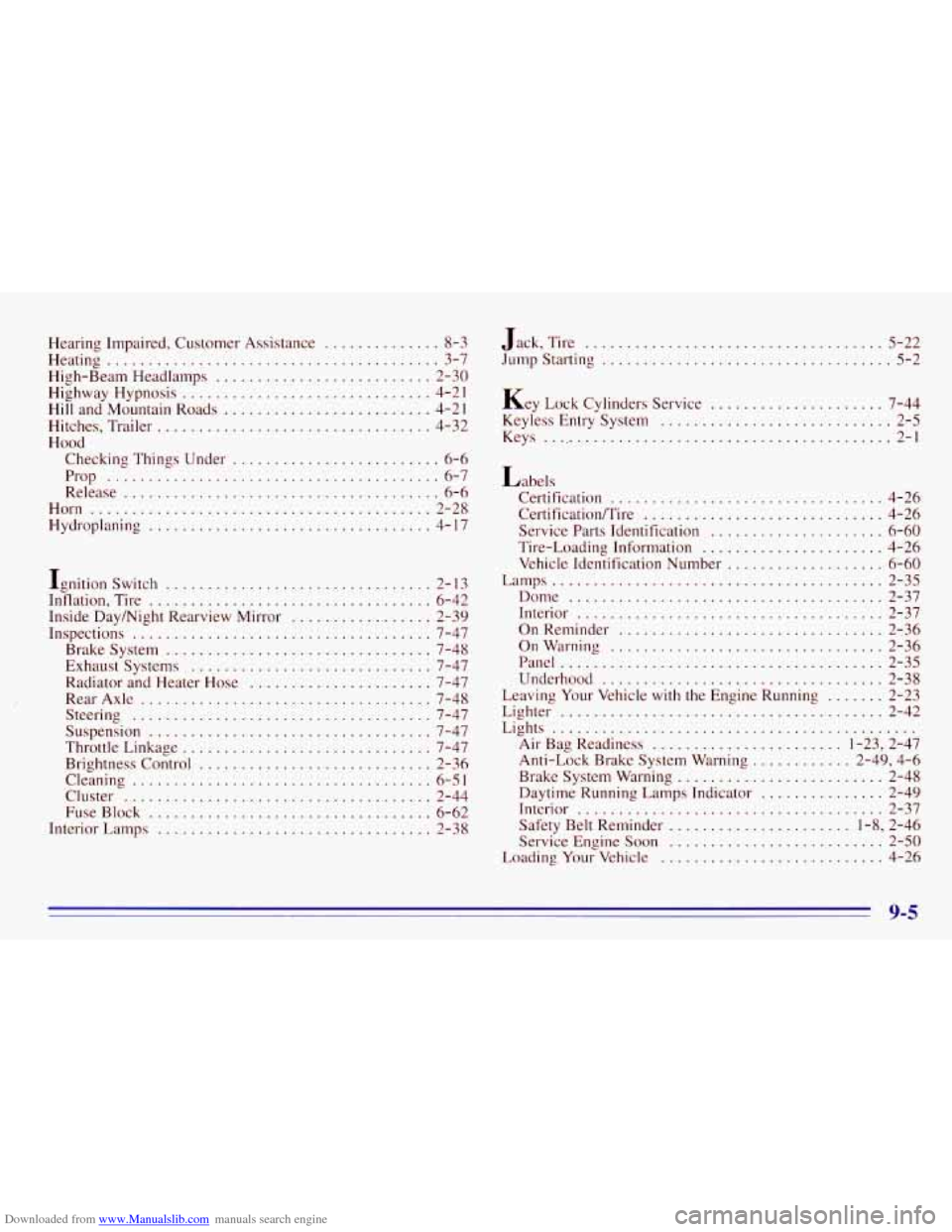
Downloaded from www.Manualslib.com manuals search engine Hearing Impaired. Customer Assistance .............. 8-3
Heating
........................................ 3-7
High-Beam Headlamps
.......................... 2-30
Highway Hypnosis
.............................. 4-21
Hill and Mountain Roads ......................... 4-21
Hitches. Trailer ................................. 4-32
Hood Checking Things Under
......................... 6-6
Prop ........................................ 6-7
Release
...................................... 6-6
Horn ......................................... 2-28
Hydroplaning
.................................. 4- I7
Ignition Switch ................................ 2- 13
Inflation. Tire
.................................. 6-42
Inside Daymight Rearview Mirror
................. 2-39
Inspections
.................................... 7-47
Brakesystem
................................ 7-48
Exhaust Systems
............................. 7-47
Radiator and Heater Hose
...................... 7-47
RearAxle
................................... 7-48
Steering
.................................... 7-47
Suspension
.................................. 7-47
Throttle Linkage
.............................. 7-47
Brightness Control
............................ 2-36
Cleaning
.................................... 6-51
Cluster
..................................... 2-44
FuseBlock
.................................. 6-62
Interior Lamps
................................. 2-38
Jack. Ere .................................... 5-22
Jump Starting ................................... 5-2
Key Lock Cylinders Service ..................... 7-44
Keyless Entry System
............................ 2-5
Keys
........................................... 2-1
Labels Certification
................................. 4-26
Certificationflire
............................. 4-26
Service Parts Identification
..................... 6-60
Tire-Loading Information
...................... 4-26
Vehicle Identification Number
................... 6-60
Lamps
........................................ 2-35
Dome
...................................... 2-37
Interior
..................................... 2-37
OnReminder
................................ 2-36
Onwarning
................................. 2-36
Panel
....................................... 2-35
Underhood
.................................. 2-38
Leaving Your Vehicle with the Engine Running
....... 2-23
Lighter
....................................... 2-42
Lights
............................................
Air Bag Readiness ....................... 1-23. 2-47
Anti-Lock Brake System Warning
............ 2.49. 4.6
Brake System Warning
......................... 2-48
Daytime Running Lamps Indicator
............... 2-49
Interior
..................................... 2-37
Safety Belt Reminder
...................... 1-23. 2-46
Service Engine
Soon .......................... 2-50
Loading Your Vehicle
........................... 4-26
9-5
Page 374 of 376
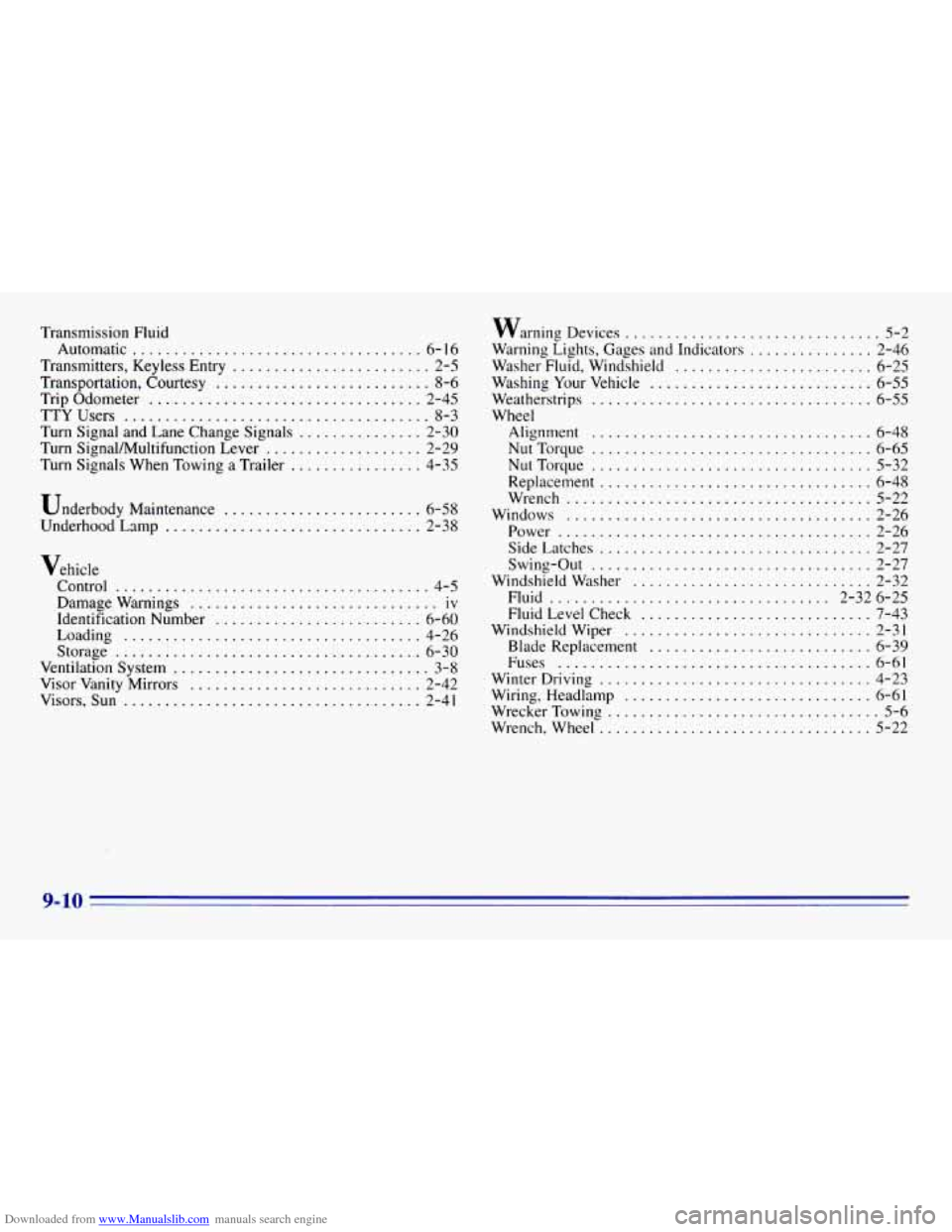
Downloaded from www.Manualslib.com manuals search engine Transmission Fluid Automatic
................................... 6- 16
Transmitters. Keyless Entry ........................ 2-5
Transportation. Courtesy
.......................... 8-6
Trip Odometer
................................. 2-45
TTYUsers
..................................... 8-3
Turn Signal and Lane Change Signals
............... 2-30
Turn SignalA4ultifunction Lever
................... 2-29
Turn Signals When Towing
a Trailer ................ 4-35
Underbody Maintenance
........................ 6-58
UnderhoodLamp
............................... 2-38
Vehicle Control
...................................... 4-5
Damage Warnings
.............................. iv
Identification Number ......................... 6-60
Loading
.................................... 4-26
Ventilation System
............................... 3-8
Visor Vanity Mirrors
............................ 2-42
Visors, Sun
.................................. 2-41
Storage
..................................... 6-30 warning
Devices
............................... 5-2
Warning Lights. Gages and Indicators
............... 2-36
Washer Fluid. Windshield
........................ 6-25
Washing Your Vehicle
........................... 6-55
Weatherstrips
.................................. 6-55
Wheel Alignment
.................................. 6-48
NutTorque
.................................. 6-65
NutTorque
.................................. 5-32
Replacement
................................. 6-48
Wrench
..................................... 5-22
Windows
..................................... 2-26
Power
...................................... 2-26
SideLatches
................................. 2-27
Swing-Out
.................................. 2-27
Windshield Washer
............................. 2-32
Fluid
.................................. 2-326-25
FluidLevelCheck
............................ 7-43
Windshield Wiper
.............................. 2-31
Blade Replacement
........................... 6-39
Fuses
...................................... 6-61
Winter Driving
................................. 4-23
Wiring. Headlamp
.............................. 6-61
WreckerTowing ................................. 5-6
Wrench. Wheel ................................. 5-22
9-10